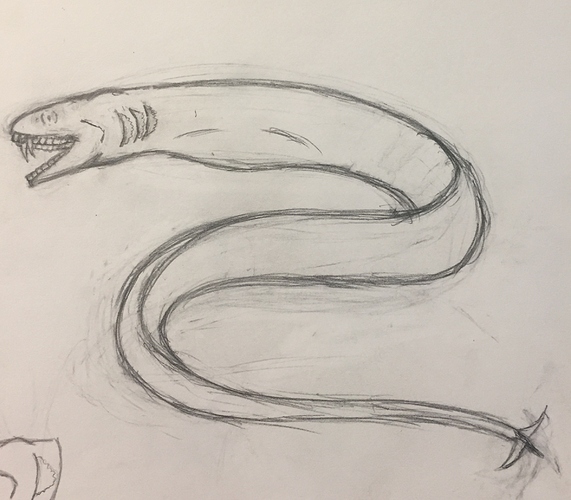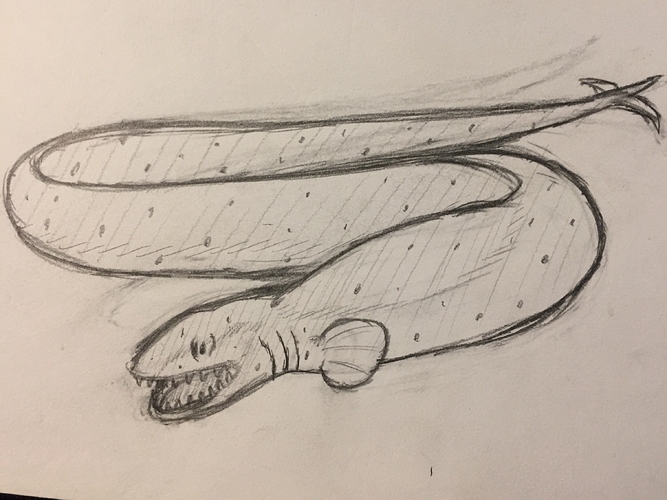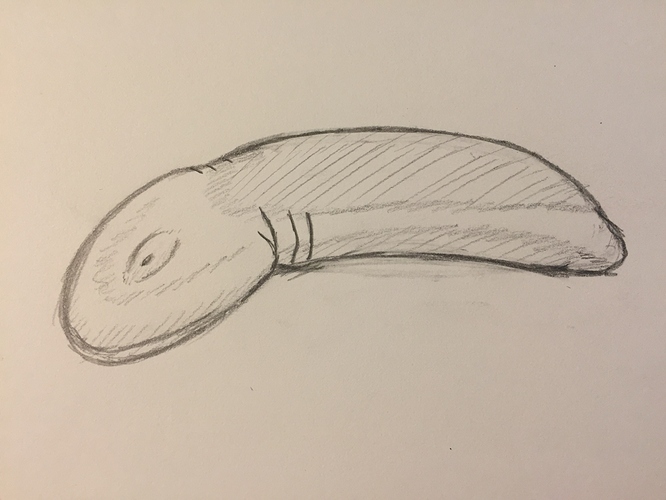Then CANIBALISM
vote:Eat the unhatched eggs
Action: Attempt to find a mate so I can get some steamy times
Action: Continue feeding on the tablemount.
Damnit, I think I’ll just venture farther out into this cave then.
Action: Venture into the cave and eat any mosses I see.
Action: Use my new nose to search for some food around (probably dead matter or chunks that a bigger predator left behind)
Action: Find a safe cave to sleep inside of
Round 60
Extra Stuff
Music: https://m.youtube.com/watch?v=T1_wnREGllg
Chat: https://discord.gg/weGdxFB
Eztan Extant Ecosystems: https://docs.google.com/document/d/1ramXIxwYwggWj1bVH3zmZT-tlZSbQvW4PUZAEiVWYB8
Book of the Dead: https://docs.google.com/document/d/1JOwzI4ZHorn8nrqEr62v2_uXXlbs7qSCudHc476qLMY
~15 million years into the Atroxian~
Pagosian Stage
Season: Northern Autumn, Southern Spring
Time of Day: Dawn (W), Afternoon (E)
Event - 4 (No Disaster)
Global Climate: The general climate of Ezta is warm, with an average global temperature of 20 degrees, and fairly wet and tropical. This is because greenhouse gases are at a decent level, but oxygen levels are now also climbing. However, many deserts stretch across the continent of Uteeno, as they are too far from the coast to recover rain. The sea levels are quite high, and there are no ice caps.
One newly evolved animal has pushed the long reigning Thanostoma aquaprinceps out of the top spot in one biome; the deep ocean. Thanostoma minor did this not by getting bigger or more dangerous, but by reducing its size and therefore it’s energy requirement, very important in the deep. As such, it has taken over the role of apex predator, and Thanostoma aquaprinceps is now solely found in shallow seas.
Some new stuff: I’ve decided to combine the fitness and nutrition bar into one. You will still lose the same amount of percentage as you would normally moving, but this is now in addition to the 15% decrease every round you don’t eat. So, if you chose to rest, you would not lose any percentage movement but only the 15% hunger penalty.
Also, when you reproduce, up to half of your energy gets given to your next generation, and the same goes for your mate. For example, if you and your mate both have 100% fitness, you will give 50% and your mate will give 50% so that your offspring (the next animal you play as) will start with a full 100%. On the other hand, if you had 40%, you could only give 30%, because you will stop at 10% to keep yourself alive. This means your next playable animal would be born with 80%, provided your mate gave 50%. This means being strong and finding a strong mate is important now.
@RoboTrannic
Veroina ericius (VU)
DEEP SOUTH-WEST UTEENESSA OCEAN
You rest in the gulley and so are slightly more hidden from predators. You safely rest and recuperate some of your energy, and reawaken. You still sense no other life, and a current gently moves over your gulley. (4 + 1)
Status
Health: Healthy
Fitness: 31/38 (82%)
Maturity: 95%
Temp: Ok
Current Size: 16cm
Veroina ericius
Status: VU
Timespan: R.52 - Present
Habitat: Deep Ocean, Continental Slope (Mid Ocean)
Distribution: Under Temperate and Tropical Uteenessa Ocean, below 1000m
Niche: Benthic Filter-Feeder
Nutritional Value: 38
Size: 16.5cm (length - although this includes spines, the body itself is 6.5cm)
Predecessor: Kapnosta limus
Classification: Veroinidae, Kardiaskulidea, Tubulosa
Latest Mutations: Fix Smell = 3, Sense of Smell = 5, Spikes = 6
Description: With the abundance of predators in these dangerous waters, it only makes sense for species to evolve extra defences. Veroina ericius have developed defences that are almost impenetrable; they have spiky spines sticking out all over their tubular body, with an average length of about 5cm. These spines are also toxic. Predators are unlikely to be able to get to the flesh underneath the spines without causing great damage to themselves. Therefore, areas that were once off-limits because of predators are now open, and Veroina ericius would be able to colonise the shallow seas, in addition to their previous range, if they were adapted to deal with the warmer temperatures. They also use these spines to walk across the seafloor but can no longer swim. Furthermore, they have lost the slime on their scales that gave them a strong smell, but have gained an olfactory sense with the appearance of olfactory receptors studded around the body. With this ability, Veroina ericius can track the smell of chemicals to hydrothermal vents and brine pools, making food easier to find in the deep ocean. All of this makes Veroina ericius the most common animal in the ocean - the only downside is that the spines make mating an awkward tangle.
Previous Mutations: Extra-Efficient Muscles, Open Circulatory System, Tubular Heart, Web of Capillaries Over Muscles, Axochord, Notochord, Four Gill Slits, Two Gill Frills, Pharynx, Large Pinhole Eyes With Lenses (2 on top of head, one on front), Heat-Proof Scales, Cartilage Vertebrae
@agenttine
Thanostoma mediossium (LC)
NORTH-WESTERN SHELF
You head further into the cave, into the darkness, shielded from light. There is no vegetation in here, just a few tiny filter-feeders utilising the cave system for shelter and as a funnel for food. Ahead of you, the cave dips deeper and out of sight. Behind you, bars of light shine in through the two entrances. (3)
Status
Health: Healthy
Fitness: 30/53 (57%)
Maturity: 10%
Temp: Ok
Current Size: 9cm
Thanostoma mediossium
Status: LC
Timespan: R.50 - Present
Habitat: Shallow Sea
Distribution: All Temperate Seas
Niche: Herbivore
Nutritional Value: 101
Size: 19cm
Predecessor: Thanostoma aquaprinceps
Classification: Makouradae, Spinacheliforme, Caudara
Latest Mutations: Digestive Enzymes = 1, Plant-Eating Teeth = 5, Bony Body = 4
Description: This is the first bony animal of Ezta, with the vertebra and jaw now being formed of bone rather than cartilage, so it is stiffer but stronger. The tail has remained cartilaginous to maintain its flexibility . At the front of the jaw is a group of very square teeth, which are the prime shape for biting off bits of vegetation. The venomous canines are now only for defence, as this animal is a complete herbivore. The bacteria in its gut are only able to break down plant matter; they require the bits of food to be even tinier and without better ways of mechanical digestion, they often regurgitate the food if it is too large. There is an abundance of food, and they are quite capable of defending themselves, which means they have a fairly stable population.
Previous Mutations: Extra-Efficient Muscles, Electroreceptors, Open Circulatory System, Axochord, Whip Tail, Three Gill Slits, Notochord, Cartilage Vertebrae, Digestive Carnivorous Bacteria, Two Poisonous Spikes on Tail, Dentine Teeth, Venomous Canines, Jaw, Two Swiveling Pinhole Eyes (1 on each side of head)
@immortaldragon
Achmachelus etalas (LC)
SOUTH-WEST UTEENESSA OCEAN, OCEAN SURFACE
Before you get much of a chance to feed any more, there is a disturbance as other filter-feeders start to rush towards you. Behind them, is a predatory Asteridermus luminaria, and almost full-sized. (1 + 1)
Status
Health: Healthy
Fitness: 2/11 (18%)
Maturity: 35%
Temp: Ok
Current Size: 2.5cm
Achmachelus etalas
Status: LC
Timespan: R.43 - Present
Habitat: Deep Ocean, Mid Ocean, Ocean Surface, Shallow Sea
Distribution: Temperate and under Tropical Uteenessa Ocean, All Temperate Seas
Niche: Pelagic Filter-Feeder
Nutritional Value: 31
Size: 7cm
Predecessor: Achmachelus subitamortis
Classification: Makryostusidae, Spinacheliforme, Caudara
Latest Mutations: N/A
Description: This filter-feeder has a liver full of oils and fats, substances lighter than water and allowing them to float. This means that they can comfortably inhabit areas of open ocean. The depth doesn’t bother them, because they have oils rather than a swim bladder and so are safe from pressure. However, they have wide ungainly fins which make for slow swimming. Cup eyes help them sense the direction of the surface and tell between daylight and nighttime.
Previous Mutations: Extra-Efficient Muscles, Electroreceptors, Open Circulatory System, Axochord, Whip Tail, Three Gill Slits, Notochord, Cartilage Vertebrae, Digestive Carnivorous Bacteria, Two Poisonous Spikes on Tail
@soundwave
Thanostoma aquaprinceps (NT)
MANAURAI SEA
You search around for a cave in which to rest, but in this area you cannot find any, and so you do not rest. (3)
Status:
Health: Healthy
Fitness: 40/49 (82%)
Maturity: 52%
Temp: Ok
Current Size: 9cm
Thanostoma aquaprinceps
Status: LC
Timespan: R.41 - Present
Habitat: Deep Ocean, Continental Slope (Mid Ocean), Shallow Sea
Distribution: Under Temperate and Tropical Uteenessa Ocean, All Temperate Seas
Niche: Apex Predator
Nutritional Value: 80
Size: 17cm
Predecessor: Makoura jousteri
Classification: Makouradae, Spinacheliforme, Caudara
Latest Mutations: Blue Pigmentation = 3, Pinhole eyes = 6, Jaw = 5
Description: The outwards-jutting tusks of their ancestors have morphed into long, dangerous and venomous canines which are a deadly contribution to the new jaw. Two large pinhole eyes, that the animal is able to swivel slightly for increased range of sight, on the side of the head scan the ocean for prey. Few animals can withstand an attack from this mouth. All of this makes this species the top predator of its time, as well as also being able to occupy shallow water thanks to its blue pigment. It is only restricted by its lack of buoyancy.
Previous Mutations: Extra-Efficient Muscles, Electroreceptors, Open Circulatory System, Axochord, Whip Tail, Three Gill Slits, Notochord, Cartilage Vertebrae, Digestive Carnivorous Bacteria, Two Poisonous Spikes on Tail, Dentine Teeth, Venomous Canines, Cup Eyes
@blackink
Asteridermus luminaria (EN)
DEEP SOUTH-WESTERN UTEENESSA OCEAN
From one direction, a slightly metallic smell reaches your olfactory receptors. It doesn’t smell exactly like food, but it could be something. Swimming towards your destination, the current picks you up, and you become plankton. Luckily, it’s heading the way you wanted to go anyway. The smell becomes stronger, until with that and the heat, you realise you are near by. Once there, your electroreception detects the presence of an animal, only slightly larger than you. It is a Glistroskulus. You straight in for the kill, and with a swish of your tail, the animal is fatally wounded. You feed on the corpse, and as you grow, you are no longer planktonic. (6 + 1 = You have earned a bonus +1 or -1 for any player, including yourself, next round.)
Status
Health: Healthy
Fitness: 4/14 (29%)
Maturity: 43%
Temp: Ok
Current Size: 3cm
Asteridermus luminaria
Status: VU
Timespan: R.59 - Present
Habitat: Deep Ocean, Continental Slope (Mid Ocean), Shallow Sea
Distribution: Under Temperate and Tropical Uteenessa Ocean, All Temperate Seas
Niche: Minor Predator
Nutritional Value: 33
Size: 7cm
Predecessor: Asteridermus gibbosi
Classification: Makryostusidae, Spinacheliforme, Caudara
Latest Mutations: Olfaction = 4, Temperature Tolerance = 6, Control Bioluminescence = 3
Description: This species very closely resembles its ancestor, owning a long tapering body with flashing bioluminescent lights, except it is now black. The other differences are much more difficult to spot; above the mouth, invisible to the naked eye are olfactory receptors, which provide a rudimentary way of tracking prey and mapping its surroundings. Electrolocation is still much more useful and precise. A development in the area of the brain allows Asteridermus luminaria to have more control over its bioluminescence. It can turn them on and off at will, but does so all at once with all of them. The spots cannot be controlled individually but as a group. Internally, this animal has adapted its body’s chemistry to cope with the temperatures of shallower water, including temperate and tropical seas. It is therefore much more widespread then it’s predecessor, and slightly more successful. It would live in tropical seas too, except there is no sustainable food source there for this species.
Previous Mutations: Extra-Efficient Muscles, Electroreceptors, Open Circulatory System, Axochord, Whip Tail, Three Gill Slits, Notochord, Cartilage Vertebrae, Digestive Carnivorous Bacteria, Two Poisonous Spikes on Tail, Dentine Teeth, Cup Eyes, Jaw, Fins (two vertical near head), Hump, Bioluminescent Lights
@louix
Almoskulus caecorum (NT)
DEEP SOUTHERN POLAR OCEAN
ON HOLD
Status
Health: Healthy
Fitness: 90%
Nutrition: 3/4
Maturity: 50%
Temp: Ok
Current Size: 1.15cm
Almoskulus caecorum
Status: NT
Timespan: R.57 - Present
Habitat: Continental Slope (Mid Ocean), Shallow Sea
Distribution: Uteenessa Ocean, up to 2000m below sea level, All Temperate & Polar Seas
Niche: Benthic Filter-Feeder
Nutritional Value: 7
Size: 2.3cm
Predecessor: Argoskulus rubrumi
Classification: Almoskulusidae, Squickidea, Tubulosa
Latest Mutations: Eyes = 6, Fins = 5, Defense = 1
Description: Blank, white eyeballs hang off the edge of short, protruding eyestalks that stick out straight to the sides of the head. These are the most complex eyes on Ezta. This gives them much increased coverage in terms of sight, and can see pretty much all around them, although it comes at a fairly hefty nutritional price. In order to have eyes on stalks, Almoskulus caecorum evolved a white sclera to contain the compartments of the eye, and a vitreous humour to hold its shape. There eyes are blank looking because they have no iris or pupil to control the amount of the light that reaches them. Another adaptation of this animal is the emergence of a pair of pectoral fins, close to the head. This do not aid in swimming much, but rather can be used to walk quicker across the seafloor, where the spend most of their time. They also position the head upwards and improve filtration a little. This fins are short but sturdy and curve underneath the tubular body, which varies between red and transparent. In a pinch, these fins can be used to spring upwards and utilise their membranes to glide. To avoid predators is even more crucial for this species, because their skin is especially weak and easy to cut. They thrive best on upper continental slopes, where light still reaches, but also are found commonly in open, relatively deep areas of shallow temperate and polar seas. Below the light level, their eyes becomes useless, and their weakness has no defence.
Previous Mutations: Muscles, Fleshy Membrane (along back and underside), Chemoreceptors, Basic Instincts, Three Gill Slits, Yellow Pigmentation, Dentine Teeth, Open Circulatory System, Pinhole Eye With Lens (one on top of head), Notochord, Anti-freeze Proteins, Slow Reactions, Red-Transparent Colour Shifting, Small Tentacles
@Biologicah
Codowecoi fyuxuul (LC)
DEEP NORTHERN POLAR OCEAN
Another Codowecoi has been attracted by the corpse, and soon appears. After it eats its fill, you approach it and successfully reproduce. (6 = Congratulations! You have succesfully reproduced. You may now choose 3 mutations.)
Status
Health: Healthy
Fitness: 12/11 (109%)
Maturity: 100%
Temp: Cold
Current Size: 3.5cm
Codowecoi fyuxuul
Status: LC
Timespan: R.53 - Present
Habitat: Deep Ocean, Shallow Sea
Distribution: Uteenessa Ocean, All Temperate & Polar Seas
Niche: Minor Predator
Nutritional Value: 11
Size: 3.5cm
Predecessor: Fosdelus gelida
Classification: Codowecoidae, Codowecoidea, Aquamusculida
Latest Mutations: Water Propulsion = 4, Improve photoreceptors = 5, Improve muscles = 6
Description: This species is very widespread across the floor of the deep oceans and the temperate shallow seas, where it has substrate to burrow into, which it can now do thanks to it’s hydrostatic skeleton; this is formed of circular and longitudinal muscles surrounding the body which contains water. The muscles contracting on the water of the body creates a form of locomotion. Added to this is a muscular tube, with an opening at the rear, called a hyponome. Water flows into this gap, then is expelled by the contraction of these muscles, creating a burst of speed. All in all, including the fins that it still retains, this is a relatively quick animal, although it’s form of locomotion restricts it to the seabed. It also has three cup eyes on its head, which are only useful in shallow sea populations, so it can tell the direction of light, and if the light gets blocked this can serve as a threat warning. When threatened by predators it can escape by burrowing into the substrate. Due to the hydrostatic skeleton requiring more manoeuvrability, it has lost its scales.
Previous Mutations: Bitter Chemicals, Chemoreceptors, Proboscis, Hydrostatic Muscle Fins (2 vertical near centre of body), Sharp Beak, Digestive Carnivorous Enzymes, Bigger, Blue Pigmentation, Open Circulatory System, Glittery Scales, Anti-Freeze Proteins
@svrangite
Kapnosta eremitus (VU)
SOUTH-WEST UTEENSESSA OCEAN, DEEP OCEAN
You continue to filter these desolate waters, by virtually no food comes by your spot. (2)
Status
Health: Healthy
Fitness: 2.75/5 (55%)
Maturity: 10%
Temp: Ok
Current Size: 0.85cm
Kapnosta eremitus
Status: VU
Timespan: R.43 - Present
Habitat: Hydrothermal Vents (Deep Ocean)
Distribution: Under Temperate and Tropical Uteenessa Ocean
Niche: Benthic Filter-Feeder
Nutritional Value: 50
Size: 8.5cm
Predecessor: Kapnosta limus
Classification: Kardiaskulidae, Kardiaskulidea, Tubulosa
Latest Mutations: Calcium Carbonate Shell, Heat Resistance, Tentacles
Description: Stuck to the chimneys of hydrothermal vents and the surrounding areas are hardy Kapnosta. They hide inside a limestone shell that they build around themselves which sticks to a surface permanently. They have evolved increased resistance to heat to survive such constant exposure to high temperatures. The only problem is that whilst they are safe inside their shells, they have tentacles used for catching particles of food hanging out, exposed.
Previous Mutations: Extra-Efficient Muscles, Open Circulatory System, Tubular Heart, Web of Capillaries Over Muscles, Axochord, Notochord, Four Gill Slits, Two Gill Frills, Pharynx, Large Pinhole Eyes With Lenses (2 on top of head, one on front), Heat-Proof Scales, Cartilage Vertebrae
@jellyfishmon
Thanostoma mediossium (LC)
NORTH-WESTERN SHELF
As you swim, the currents pick you up and, because of your size, you become plankton. It carries you away, but there is very little food around, with so few phytoplankton living here in the autumn. (2 + 1)
Status
Health: Healthy
Fitness: 3.5/10 (35%)
Maturity: 10%
Temp: Ok
Current Size: 1.9cm
Thanostoma mediossium
Status: LC
Timespan: R.50 - Present
Habitat: Shallow Sea
Distribution: All Temperate Seas
Niche: Herbivore
Nutritional Value: 101
Size: 19cm
Predecessor: Thanostoma aquaprinceps
Classification: Makouradae, Spinacheliforme, Caudara
Latest Mutations: Digestive Enzymes = 1, Plant-Eating Teeth = 5, Bony Body = 4
Description: This is the first bony animal of Ezta, with the vertebra and jaw now being formed of bone rather than cartilage, so it is stiffer but stronger. The tail has remained cartilaginous to maintain its flexibility . At the front of the jaw is a group of very square teeth, which are the prime shape for biting off bits of vegetation. The venomous canines are now only for defence, as this animal is a complete herbivore. The bacteria in its gut are only able to break down plant matter; they require the bits of food to be even tinier and without better ways of mechanical digestion, they often regurgitate the food if it is too large. There is an abundance of food, and they are quite capable of defending themselves, which means they have a fairly stable population.
Previous Mutations: Extra-Efficient Muscles, Electroreceptors, Open Circulatory System, Axochord, Whip Tail, Three Gill Slits, Notochord, Cartilage Vertebrae, Digestive Carnivorous Bacteria, Two Poisonous Spikes on Tail, Dentine Teeth, Venomous Canines, Jaw, Two Swiveling Pinhole Eyes (1 on each side of head)
@PositiveTower
Megalognathus dankoma (EN)
NORTHERN UTEENESSA POLAR OCEAN, DEEP OCEAN
As your siblings start hatching around you, you realise there is a nearby food supply; your siblings. You attack the nearest one with your jaws. It is caught of guard, and your sharp teeth shear into it quickly dies and you feed on it. However, your remaining siblings are drawn over by the commotion. (5)
Status
Health: Healthy
Fitness: 1/2.5 (40%)
Maturity: 35%
Temp: Ok
Current Size: 0.8cm
Megalognathus dankoma
Status: EN
Timespan: R.45 - Present
Habitat: Deep Ocean
Distribution: Uteenessa North Pole
Niche: Minor Predator
Nutritional Value: 8
Size: 2.3cm
Predecessor: Glistroskulus louixi
Classification: Megalognathusidae, Squickidea, Tubulosa
Latest Mutations: Digestive Acid = 3, Teeth = 5, Jaw = 1
Description: This species can easily be told apart from, it’s descendants by a much wider head, although it still has a small body. This head houses a jaw of razor-sharp, slicing teeth that are perfect for cutting into flesh. This flesh can be digested by the new stomach acids. But it’s jaws are proportionally very large and the jaw muscles weak; this makes both movement more tiresome, as well as the use of the jaws more difficult. Luckily, in the deep, it’s slow moving doesn’t hinder it too much as its prey struggle to detect its approach, but energy can be a problem.
Previous Mutations: Muscles, Fleshy Membrane (along back and underside), Chemoreceptors, Basic Instincts, Three Gill Slits, Yellow Pigmentation, Dentine Teeth, Open Circulatory System, Pinhole Eye With Lens (one on top of head), Notochord, Anti-freeze Proteins
I guess i’ll filter feed.
Uh-oh.
Action: Swim away! Swim away!
Action:Run Away and find food
keep resting
Action: look for food somewhere else
Mutation 1: Improve photoreceptors
Mutation 2: Lengthen body
Mutation 3: Basic limbs
Action: Hunt for food
Damn, well, I guess nothing’s in here…
Action: Leave the cave and eat vegetation.
Action: Wait for the night, use my light spots to attract an animal, and as soon as my electroreceptors feel something turn them off and hunt them with their smell as reference.
Use my -1 against soundwave (sorry man)
 Happy 1 Year Anniversary
Happy 1 Year Anniversary  I made the rest of the players species
I made the rest of the players species
Veroina ericius
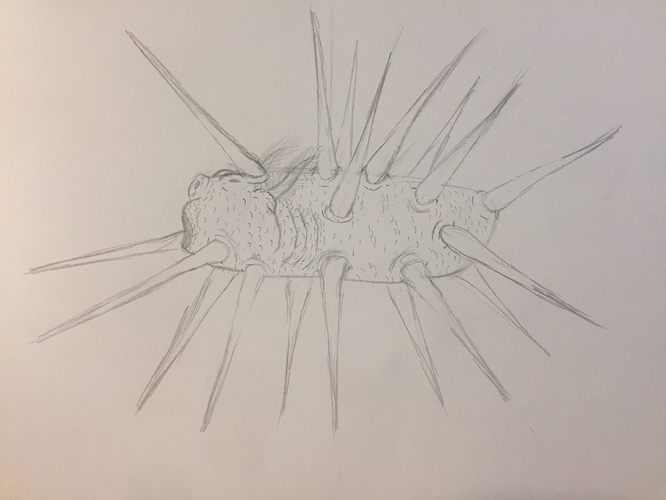
@AgentTine and jellyfish
Achmachelus etalas
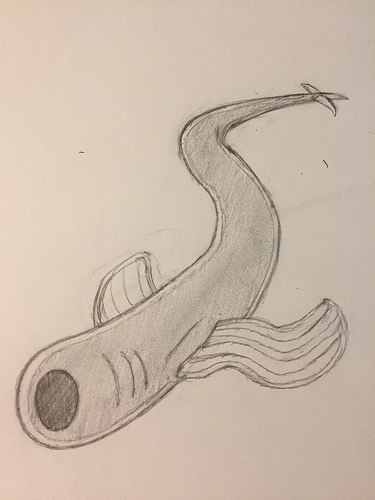
Thanostoma aquaprinceps
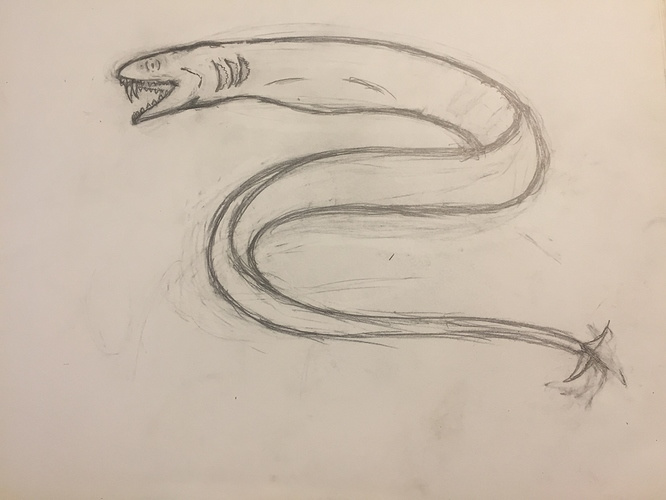
 Wow…
Wow…
That’s only the part of the game on this forum. It started on the old one.
and to think for a good chunk of that i didn’t evolve
